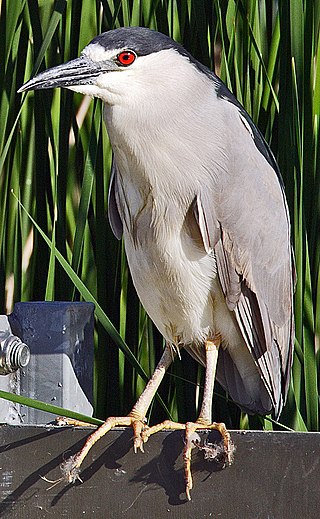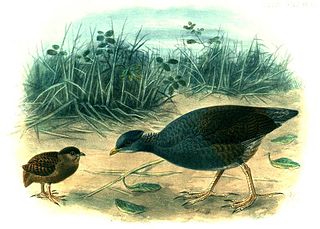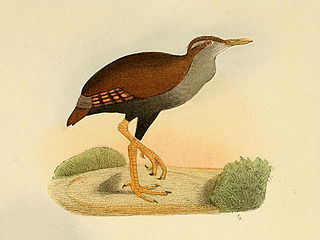
Moa are an extinct group of flightless birds formerly endemic to New Zealand. During the Late Pleistocene-Holocene, there were nine species. The two largest species, Dinornis robustus and Dinornis novaezelandiae, reached about 3.6 metres (12 ft) in height with neck outstretched, and weighed about 230 kilograms (510 lb) while the smallest, the bush moa, was around the size of a turkey. Estimates of the moa population when Polynesians settled New Zealand circa 1300 vary between 58,000 and approximately 2.5 million.

The laughing owl, also known as whēkau or the white-faced owl, is an extinct species of owl that was endemic to New Zealand. Plentiful when European settlers arrived in New Zealand, its scientific description was published in 1845, but it was largely or completely extinct by 1914. The species was traditionally considered to belong to the monotypic genus Sceloglaux Kaup, 1848, although recent genetic studies indicate that it belongs with the boobook owls in the genus Ninox.

Nycticorax is a genus of night herons. The name Nycticorax means "night raven" and derives from the Ancient Greek νύκτος, nuktos "night" and κοραξ, korax, "raven". It refers to the largely nocturnal feeding habits of this group of birds, and the croaking crow-like call of the best known species, the black-crowned night heron.

The North Island takahē is an extinct rail that was found in the North Island of New Zealand.

Gallirallus is a genus of rails that live in the Australasian-Pacific region. The genus is characterised by an ability to colonise relatively small and isolated islands and thereafter to evolve flightless forms, many of which became extinct following Polynesian settlement.

The Tongan megapode is a species of bird in the megapode family, Megapodiidae, currently endemic to Tonga. The species is also known as the Polynesian megapode, and as the Niuafo'ou megapode after the island of Niuafo'ou to which it was restricted for many years. The specific epithet honours British consul William Thomas Pritchard.

The bar-winged rail is an extinct species of bird in the family Rallidae. It was endemic to Fiji and was last collected ca 1890 in Viti Levu. The species was identified from twelve 19th century specimens, some of which are known to be in Boston, London and New York. The last unconfirmed sighting of this bird was in 1973.
Trevor Henry Worthy is an Australia-based paleozoologist from New Zealand, known for his research on moa and other extinct vertebrates.
Hodgens' waterhen is an extinct rail species from New Zealand. Its name commemorates the Hodgen brothers who were owners of the Pyramid Valley swamp where the holotype was discovered. It reached a weight of 280 g and its wings were so reduced that it was unable to fly. It occupied a wide range of habitats, including open forest and grassland along riverbanks.

The snipe-rail is an extinct flightless rail endemic to the North Island of New Zealand. The species' name is derived from the Karamu Cave 21 kilometres (13 mi) from Hamilton where the holotype was discovered in 1954.
Bountyphaps obsoleta is an extinct species of pigeon. It was described in 2008 as a new genus and species from subfossil remains found on Henderson Island in the Pitcairn Group of southeastern Polynesia. Additionally, an indeterminate species, possibly the same as B. obsoleta, has been found in the Gambier archipelago.
Vitirallus watlingi, the Fiji rail or Viti Levu rail, was a prehistoric flightless bird from Fiji, and is the only species in the genus Vitirallus. Vitirallus watlingi is thought to have been about the same size as the bar-winged rail but with a very elongated and slender bill.
The Tubuai rail is an extinct species of flightless bird in the Rallidae, or rail family.
The Niue night heron is an extinct night heron species that was endemic to the island of Niue in West Polynesia.
Megavitiornis altirostris is an extinct, flightless, giant stem-galliform bird that was endemic to Fiji, it is the only known species in the genus Megavitiornis. Originally thought to be a megapode, more recent morphological studies indicate a close relationship with Sylviornis of New Caledonia, with both genera belonging to the family Sylviornithidae outside of the Galliformes crown group. It is likely that it became extinct through overhunting shortly after the colonisation of the Fiji Islands by humans.
The New Zealand coot is an extinct bird in the rail family, Rallidae, that was endemic to New Zealand. It was described in 1893 by New Zealand naturalist, ethnologist and museum director Augustus Hamilton, from material he had collected the previous year at Castle Rocks on the Ōreti River in Southland. The Latin specific epithet prisca means "old", referring to its subfossil occurrence. Remains have subsequently been found at several sites in both North and South Islands.
Manuherikia is a genus of extinct species of ducks from the Miocene of New Zealand. It was described from fossil material of the Saint Bathans Fauna, in the lower Bannockburn Formation of the Manuherikia Group, found by the Manuherikia River in the Central Otago region of the South Island. The genus name comes from the name of the geological formation in which the fossils were found and, ultimately, from the Manuherikia River and its valley.
Miotadorna is a genus of extinct tadornine ducks from the Miocene of New Zealand. It contains two species, M. sanctibathansi, and M. catrionae.
Imber's petrel is an extinct seabird of gadfly petrel from the Chatham Islands. The species' epithet commemorates New Zealand ornithologist Mike Imber (1940–2011).







